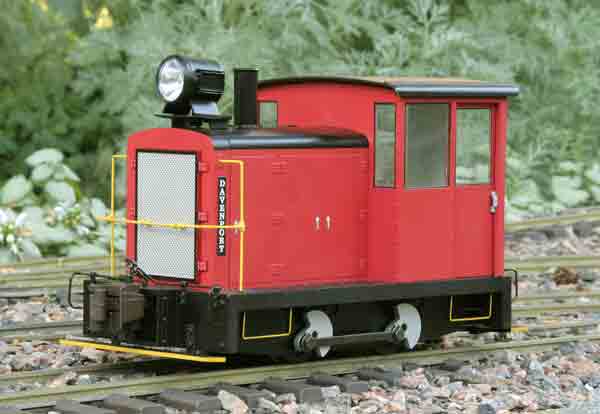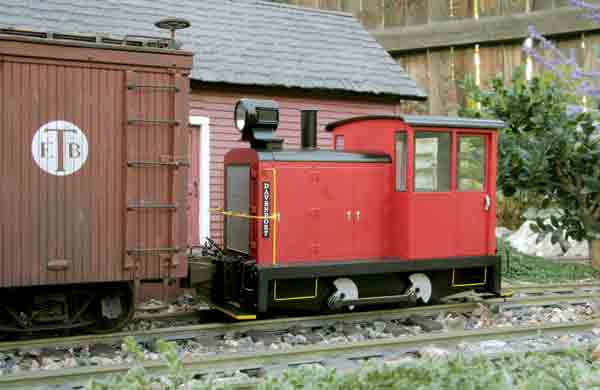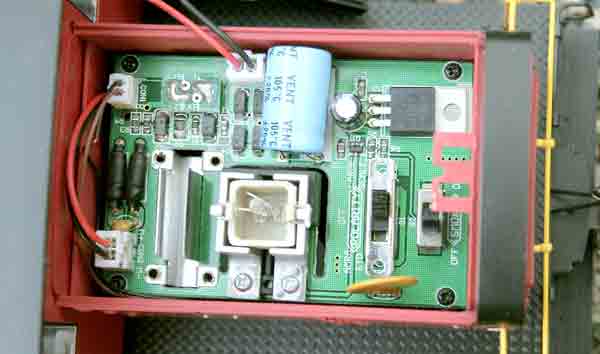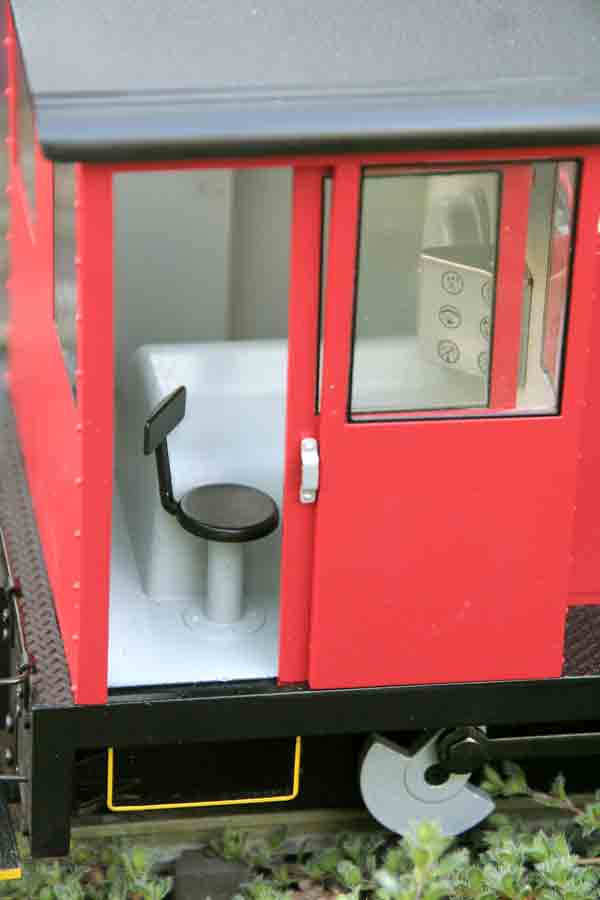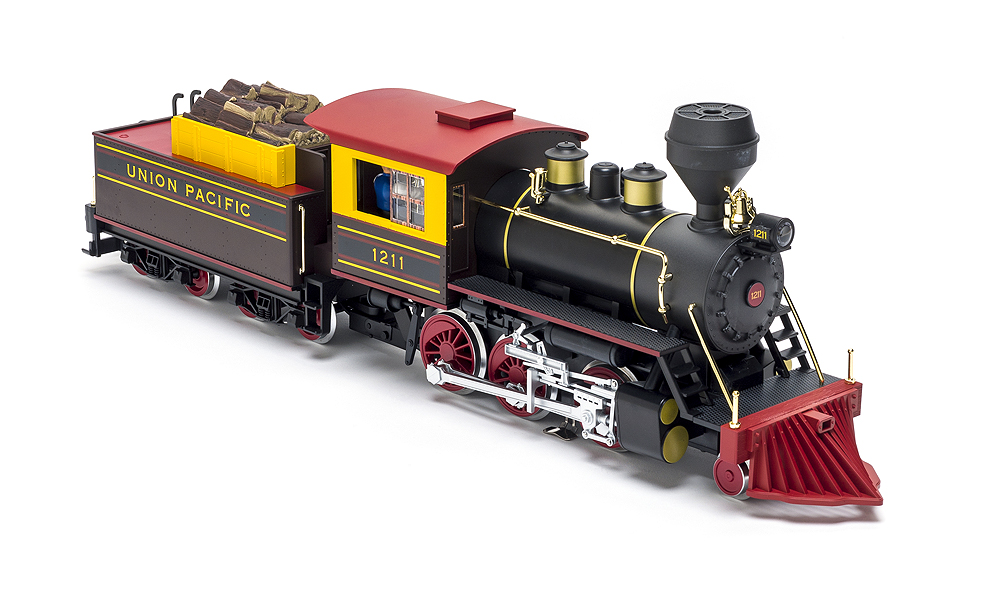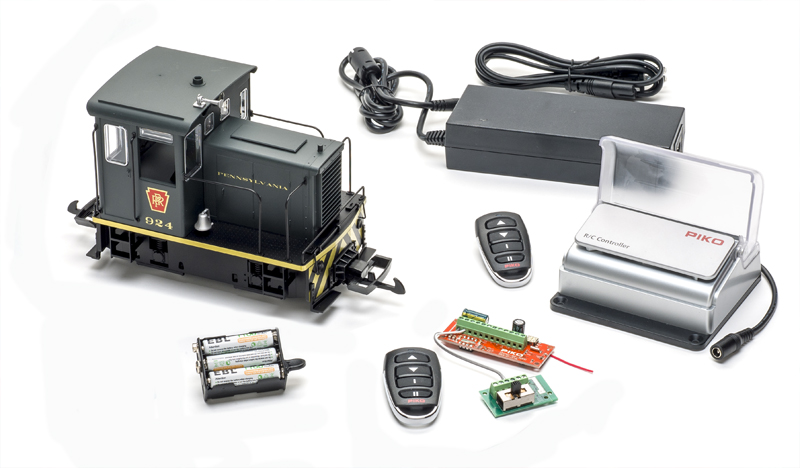1:20.3-scale, gauge 1, side rod, gas-mechanical locomotive
Bachmann Industries
1400 East Erie Ave.
Philadelphia PA 19124
Price: $275
Web site www.bachmanntrains.com
Plastic and die-cast-metal industrial gas-mechanical switcher; two powered axles; cab interior; smoke unit; directional lighting; two sets of knuckle couplers; polarity switch; DCC-ready using NMRA standard 8-pin plug. Dimensions: length, 7¾” (over footboards); width, 3¾”; height, 5″. In 1:20.3, this scales out to 13’1″ x 6’4″ x 8’5½”, respectively. Minimum radius, 2′
Pros: Smooth-running drive; compact size will appeal to fans of industrial railroads; locomotive is small and generic enough in appearance to fit well visually with 1:22.5 and 1:24 models as well; correct scale/gauge combination
Cons: Handrail supports on front attach unprotoypically to the radiator itself instead of the frame; wires from track pick-ups to control board are undersized for potential current draw
Bachmann’s model is typical of the small, narrow gauge, gas-mechanical locomotives produced by Davenport. I’ve only seen one photo in connection with this particular locomotive, though there’s no confirmation that the locomotive in the photo is the specific prototype for the model. Details on the model are very close, though not necessarily identical, to the locomotive in that photo. In comparing the model to photos and specs of other Davenport locomotives (both standard and narrow gauge), I can surmise that the unit modeled is most likely a 20 ton, 3′-gauge locomotive.
The engine itself is small. At just under 8″ long and a mere 33/4″ wide, the locomotive will look great in front of a string of small mine cars, four-wheel flats, or other industrial cars, which locomotives of this type would commonly be employed in moving. It would also be prototypically dwarfed by a “full-size” narrow-gauge box car, which, in my opinion, adds to the character of this engine. Because of its small size, it could work for those who model in 1:22.5 and 1:24, and who are looking for a small gas- or diesel-powered locomotive. Comparatively, the locomotive would probably scale closer to a 25-ton unit in those smaller scales.
The locomotive comes with a smoke unit, working directional headlight, Bachmann’s knuckle couplers, and operating sliding doors on the cab. The locomotive comes with two sets of couplers-one for their 1:20.3 freight equipment, and a replacement set that lowers the coupler
to match their older 1:22.5 equipment. Swapping them out is a simple matter of removing the cover plate from underneath and replacing the existing couplers with the new ones. You can also directly replace the couplers with Kadee #830 (G-scale) couplers. Other couplers, such as those from Accucraft, may be harder to fit due to the thickness of the loco’s die-cast frame.
Details on the switcher are well done. There’s a rudimentary cab interior, with a swiveling chair and control station. There’s a sizable hump in the floor that covers the motor, but it’s below the window line, so it blends in fairly well. The headlight is the same that Bachmann uses on some of its steam locomotives. It’s larger than those typically found on small industrial locomotives of this size but, since these locomotives were often customized by their owners, it’s hard to claim it’s “unprototypical.” The handles on the doors along the hood are molded in. I think it would have been cool for these to have been separate parts but, between the slight relief they do have and the silver paint neatly applied to them, they look more 3-D than they really are. The only glaringly “unprototypical” details on this loco are the handrail supports on the front of the locomotive. These attach to the radiator itself instead of the frame around it. While this is a minor and easily correctable point, it would have been equally easy to have done them correctly in the first place. The switcher comes in a variety of colors, though none are lettered for any railroad. The paint is clean and even.
Operationally, the locomotive does well, running smoothly from low to high speeds. Both axles are powered, so the side rods on this locomotive are purely cosmetic. The gearing is a bit faster than I’d like to see, so speeds are on the high side compared with those at which the engine would typically operate. At 7.2V (a standard NiCad battery pack), the locomotive trundles along at around 10 mph, which is a more prototypical speed. That’s good news for those who run battery power, since there’s not a lot of room for batteries. Wheels have a back-to-back spacing of 1.570″-within tolerances for G1MRA standards.
Our review sample started moving at 1.7V, drawing .14 amps. Slipping, the locomotive drew .79 amps; stalled, it drew 2.2 amps. The engine isn’t a power hog, which is good. More on that later. With the wheels slipping, the locomotive manages 16 ounces of drawbar pull, or around 13 average freight cars on straight, level track. That’s typical of what a small locomotive like this could actually pull. It did manage to pull two Accucraft passenger cars up a 4% grade, so a string of mining cars should be just fine in tow.
The locomotive comes with a DCC-ready control board, located under the removable hood. On this board, you’ll find a switch to control the smoke unit, as well as a three-position switch that lets you select the polarity of the power going to the motor (Large Scale standard or NMRA standard-they’re opposite) or, if set in the middle, turn the locomotive off. The board also has a built-in circuit breaker, which, according to the component manufacturer’s specs (not Bachmann’s), will trip at just over 2.5 amps maximum current.
Also on this board is an eight-pin DCC plug. This is not the “plug-and-play” socket Bachmann used in its K-27. Rather, it is a much smaller, NMRA-standard plug that will interface with many of the DCC control boards currently on the market for the smaller scales. Therein lies a minor issue. You must make sure that the DCC controller you chose will be able to handle the current draw of the locomotive. A 1-amp-capacity circuit should be the absolute minimum, though, to be safe, I’d look for a 1.5-amp controller. There is a metal clip on the board to hold the DCC control. Make sure that your control is wrapped in plastic or electrical tape, so the metal clip doesn’t accidentally short it out. There’s an opening in the floor in front of the weights for a 1.5″ speaker, should you want to install a sound system, and there’s a bit of space under the PC board for the sound-system board.
There is no provision on the PC board for R/C control, but the stock board would have to be removed to make room for batteries anyway, so that’s not an issue. There is a grand total of six wires in this locomotive, so it’s not difficult to figure out which wire goes where.
On the subject of wires, there’s one curiosity that jumped out at me. The wires running from the track pickups to the PC board are about half the size of those going from the PC board to the motor and headlight. They are arguably too thin to be used in that application. Based on the diameter of the wire and AWG (American Wire Gauge) guidelines, the wires going from the track to the PC board are rated at around 0.2 amps continuous draw. With no load, the locomotive is under that threshold but, at slip, the locomotive draws four times that amount. Under a normal load, the locomotive will draw somewhere between those two values, surpassing the recommended current limit of the wires-especially if using the smoke unit and/or powering DCC and sound boards.
There are two problems that could arise from this. First, the wires begin to act as resistors, limiting the voltage to the locomotive, thus slowing it down. Second, the wires may overheat due to the excessive current, leading to a short circuit if the insulation melts. Having said that, I ran the locomotive with some weights on it to push the current draw up to 1.2 amps for 20 minutes, and noticed no heat buildup in the wires. So, while it is certainly something to keep an eye on, it doesn’t appear to be a fatal flaw.
Bottom line, I’m impressed with this locomotive. It runs well and has lots of character. If it’s anything like its 0n30 forerunner, I think it will awaken the creative genius in many of us. Expect to see many customizations on this one.





